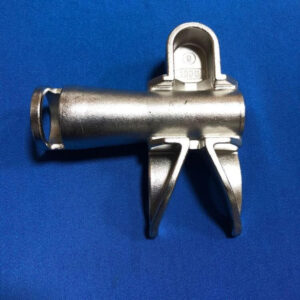8620 Steel Forging
What is 8620 Steel Forging?
8620 Steel Forging is a manufacturing process where a billet or bar of 8620 steel is heated to a plastic state and then shaped into a specific, high-strength component using compressive forces, typically from a hammer or press and a set of dies. This process aligns the metal’s grain flow to the contours of the part, resulting in superior mechanical properties compared to parts made by casting or machining from bar stock.
8620 steel is a nickel-chromium-molybdenum low-alloy steel known for its excellent case hardenability. After forging, components are often heat-treated (carburizing or carbonitriding) to create a very hard, wear-resistant surface case while maintaining a tough and ductile core. This combination makes it ideal for high-stress applications.

Chemical Elements of 8620 Steel
he chemical composition of 8620 steel is defined by standards such as AISI (American Iron and Steel Institute). The key elements and their typical ranges are:
| Element | Percentage (%) | Role in the Steel |
|---|---|---|
| Iron (Fe) | ~97% | Base metal. |
| Carbon (C) | 0.18 – 0.23 | Provides basic hardness and strength. |
| Manganese (Mn) | 0.70 – 0.90 | Increases hardenability and strength. |
| Phosphorus (P) | ≤ 0.035 | Impurity; kept low to prevent brittleness. |
| Sulfur (S) | ≤ 0.040 | Impurity; improves machinability but can reduce toughness. |
| Silicon (Si) | 0.15 – 0.35 | Deoxidizer; increases strength. |
| Nickel (Ni) | 0.40 – 0.70 | Enhances toughness and core strength. |
| Chromium (Cr) | 0.40 – 0.60 | Improves hardenability and wear resistance. |
| Molybdenum (Mo) | 0.15 – 0.25 | Increases hardenability, strength, and resistance to tempering. |
The synergistic effect of Ni, Cr, and Mo is what gives 8620 steel its outstanding core properties after heat treatment.
Applications of 8620 Steel Forgings
8620 steel forgings are used in a wide range of industries that require high-strength, wear-resistant, and durable components. Key industries include:
Automotive & Transportation: Gears, pinions, axle shafts, universal joint crosses, crankshafts, piston pins, and other critical powertrain and drivetrain components.
Aerospace: Aircraft landing gear components, engine mounts, arresting hooks, and other high-structural integrity parts.
Oil & Gas: Drill bit cones, tool joints, mandrels, valve bodies, and other downhole and drilling equipment subjected to high stress and abrasion.
Heavy Machinery & Equipment: Gears, sprockets, rollers, pins, and linkages for construction, mining, and agricultural machinery.
Power Transmission: High-performance gears and shafts for wind turbines, industrial gearboxes, and marine propulsion systems.
Defense: Track shoes for tanks, gun mounts, and other armored vehicle components.

The 8620 Steel Forging Process
The closed-die forging process for 8620 steel typically involves the following key steps:
Billet Cutting: Raw 8620 steel bars are cut to precise weights (slugs) required for the final forging.
Heating: The slugs are heated in a furnace to a specific forging temperature, typically between 2150°F – 2250°F (1175°C – 1230°C), to make the steel plastic and malleable.
Forging: The heated slug is placed into the lower half of a set of precision-machined dies. The upper die descends with immense force (from a mechanical or hydraulic press), shaping the metal to fill the die cavity. This is often done in multiple stages (blocking, finishing) to ensure proper metal flow and detail.
Trimming: After forging, the excess metal (flash) surrounding the part is trimmed off in a separate press.
Heat Treatment (Annealing/Normalizing): The forgings are heated and cooled to relieve internal stresses from forging and to refine the grain structure, preparing them for machining and final heat treatment.
Shot Blasting: The parts are cleaned in a shot blaster to remove scale and improve surface appearance.
Inspection & Testing: Rough-machined or full-machined parts are inspected for dimensions and quality. Testing like magnetic particle inspection (MPI) or ultrasonic testing (UT) can be performed to detect internal or surface defects.
Final Machining & Heat Treatment: The customer typically performs final machining to precise tolerances, followed by the final heat treatment (usually carburizing) to achieve the desired hard case and tough core.
Our 8620 Steel Forging Capabilities for Our Customers
We are a professional manufacturer capable of producing high-quality 8620 Steel Forgings to meet your specific requirements.
Our capabilities include:
Custom Die Design & Manufacturing: We design and build our own precision dies to your part prints.
Full-Range Forging: We can forge 8620 steel components from a few pounds up to several hundred pounds.
Precision Process Control: We strictly control the entire process—from material certification and heating to forging and cooling—to ensure superior grain flow and mechanical properties.
Secondary Services: We offer a range of value-added services, including rough machining, heat treatment (annealing, normalizing, quenching & tempering), shot blasting, and comprehensive non-destructive testing (NDT).
Quality Assurance: Our commitment to quality ensures that every 8620 steel forging we deliver meets or exceeds industry standards and your specifications.
We are ready to be your reliable partner for high-performance 8620 steel forged components. Contact us today to discuss your project and receive a quotation.
